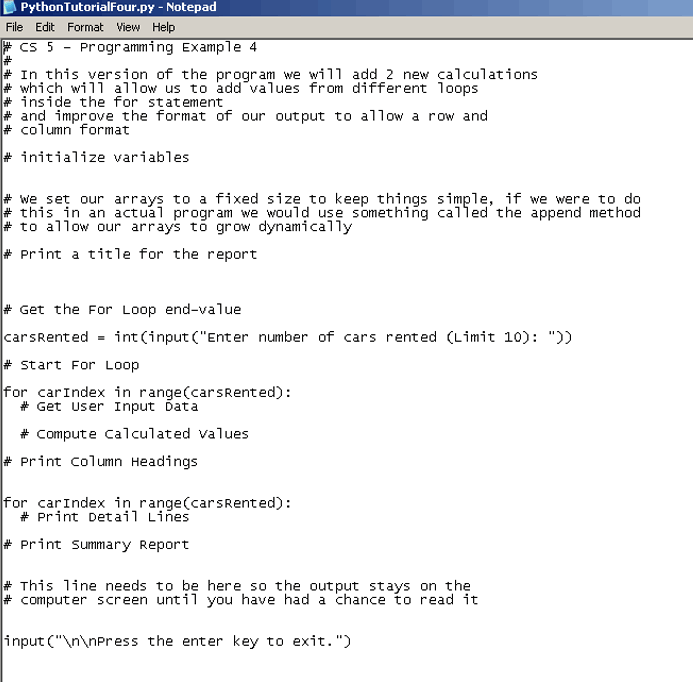- Open Notepad (in Windows) or TextEdit (on a Mac)
- Click this link to see the
PythonTutorialFour.python
starter file
- Copy the contents into Notepad or TextEdit
- Save the Notepad or TextEdit file using the name PythonTutorialFour.py
- Open the file using the Notepad or TextEdit application
|
Your file should look something like this:

|
|
Add the new variables needed for the new functionality of program four.
|
-
Enter the code shown below after the comment that says "Initialize Variables"
carType = [0,0,0,0,0,0,0,0,0,0]
# Holds the car types
startMiles = [0,0,0,0,0,0,0,0,0,0]
# Holds the starting
odometer readings
endMiles = [0,0,0,0,0,0,0,0,0,0]
# Holds the ending
odometer readings
gallonsUsed = [0,0,0,0,0,0,0,0,0,0]
# Holds the number of gallons used
totalMiles = [0,0,0,0,0,0,0,0,0,0]
# Holds the total
miles driven
milesPerGallon = [0,0,0,0,0,0,0,0,0,0]
# Holds the miles per gallon
carMessage = [0,0,0,0,0,0,0,0,0,0]
# Holds the economy designation
carIndex =0
# Holds the
counter for the "for"loop
mpgAccumulator = 0
# Holds the total mpg for
all cars
averageMPG = 0
# Holds the average mpg for all cars
carsRented = 0
# Holds the number of cars rented
Notice that we have taken a new approach in storing variables here. We are using
called an Array (or "list" in Python). Not only does it allow us to store several
pieces of like information together, we can use the loop index variable to help us
store in a structured grid.
|
|
It is common for a program to have some sort of title that tells the user what the program
does and it might include the name of the person (or Company) who wrote the program.
|
-
Enter the code shown below after the comment that says "Print a Title for the report"
print("\n Your Name Here - Programming Tutorial Four")
# The \n is a new line
print("\n")
print("\n Average MPG across multiple cars")
print("\n")
|
|
The user input data will be a little different since we are now using an Array (or "list")
|
-
Enter the code shown below after the comment that says "Get User Input Data"
carType[carIndex] = input("Enter make of car: ")
startMiles[carIndex] = int(input("Enter beginning odometer reading: "))
endMiles[carIndex] = int(input("Enter ending odometer reading: "))
gallonsUsed[carIndex] = float(input("How many gallons? "))
Be sure to notice that these are indented. It will not work without the indent.
|
It is not time for the program to do some calculations. As it turns out, we have 2 kinds of
calculations in this program:
- a calculation of user input data
- a calculation of a variable that has itself been calculated by this program
The first type of calculation I can do whenever I want to, but I must do the 2nd type of
calculation after I have performed the calculation required as its input. Let's see what
I mean:
|
-
Enter the code shown below after the comment that says "Compute Calculated Values"
totalMiles[carIndex] = endMiles[carIndex] - startMiles[carIndex]
milesPerGallon[carIndex] = totalMiles[carIndex] / gallonsUsed[carIndex]
mpgAccumulator = mpgAccumulator + milesPerGallon[carIndex]
if milesPerGallon[carIndex] > 30:
carMessage[carIndex] = "Yes"
else:
carMessage[carIndex] = "No"
Notice the role that carIndex variable now plays in this program.
|
|
Now we are really going to do something different. We are going to use Python's text
formatting syntax to create a tabular output. This next section of code creates the column
labels. Each field is 18 spaces wide and the first one is left justified.
|
-
Enter the code shown below after the comment that says "Print Column Headings"
print()
print("%-18s" % "Make of Car: " , end=" ")
print("%18s" % "Miles Driven: " , end=" ")
print("%18s" % "Miles Per Gallon: " , end=" ")
print("%18s" % "Ecomony: ")
print()
|
|
We will once again make use of the "for" loop and the carIndex variable to output all the
information we stored in our array.
|
-
Enter the code shown below after the comment that says "Print Detail Lines"
print("%-18s" % carType[carIndex] , end=" ")
print("%18d" % totalMiles[carIndex] , end=" ")
print("%18d" % milesPerGallon[carIndex] , end=" ")
print("%18s" % carMessage[carIndex])
|
|
One last set of information to print. The following code prints the summary and average
information.
|
-
Enter the code shown below after the comment that says "Print Summary Reports"
print()
averageMPG =mpgAccumulator / carsRented
print("Report Summary: " ,carsRented," cars were processed with an average mileage
value of")
print(averageMPG, ".")
|
Save your program to your student disk. Change the name of the program so you know this is
the completed version.
Note: Be sure the name ends with ".py -- this is what lets the Python Interpreter
identify and run your program.
|


